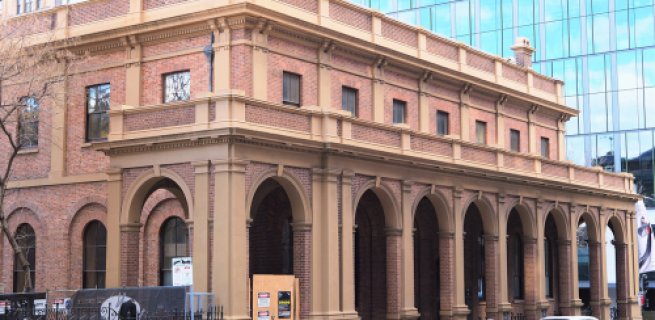In early-1890s Sydney, Pasquale Besomo ran a matrimonial bureau, which was a service that matched up people who wanted to get married. The Redfern local also ran a related newspaper called Matrimony.
An older German man by the name of Talegrin entered into negotiations with Besomo with the hope of meeting a woman who might become his wife. However, when the venture didn’t work out, Besomo ceased communications with the 60-year-old Pyrmont resident.
Another Sydney marriage expert, Jean Louie, then commenced fresh negotiations with Talegrin. Although, when it came time for his client to meet his prospective wife, it appeared it was actually a man dressed up as a woman.
Mr Louie then presented Mr Talegrin with a fake summons, claiming he’d have to appear in court in relation to a breach of a promise of marriage. And to avoid any further action, the older German man gave Louie £126 in order to halt the bogus proceedings.
NSW police then arrested Mr Louie over the conspiracy to defraud Mr Talegrin. The man was prosecuted and subsequently convicted. And Mr Besomo appeared during the proceedings and testified against the shyster.
A chance encounter
Mr Besomo went on to bring proceedings against NSW police detective Edward Keating in the NSW Supreme Court. The plaintiff aimed to recover £1,000 in damages in relation to alleged “false and malicious slander”.
The matter involved a chance meeting between Besomo and Keating on 3 June 1895 at Sydney’s Watt’s Hotel. The pair had decided to have a drink, when the landlord suggested they join a meeting in the backroom of the establishment that was already taking place with about 30 to 40 participants.
The men accepted the invitation, and Keating suggested to those gathered that they partake in a debate with Besomo acting as chair. As the conversation began, Keating recalled the Talegrin incident, and allegedly claimed that Louie was working for Besomo at the time of the fraud.
Besomo put it to the Supreme Court that Keating had charged him with an indictable offence in front of a room full of people, which considerably injured his reputation.
And on 5 December 1895, the police detective pleaded not guilty to the offence of slander – which is now part of the law of defamation in New South Wales.
A question of defamation
The alleged statement made by Keating to those gathered was supposed to have consisted of him referring to “a notorious scoundrel” named Jean Louie, who the police detective said was a “great friend” to Besomo, as well as having been his former employee.
Keating explained that Louie introduced Talegrin to Besomo, who then charged the German man £1 to advertise for a wife in his paper. And amongst the great number of applicants, the fraudsters arranged to introduce the older man to a woman from Bathurst.
However, when the arranged meeting occurred at Balmain’s Bald Rock, it was said that a man appeared dressed in women’s clothing, with a veil over his face. And it was this disguised man who then went on to start proceedings against Talegrin for breaching a marriage agreement.
Keating said the men told Talegrin that they’d claim £500 in damages if it went to court, and in order to keep this from happening, the older man agreed to pay a fee. “Our chairman knew all about this, for he himself was in the swim,” the detective concluded his account of the matter.
Before the court
On the second day of proceedings, Justice Sir George Simpson heard testimony from Besomo regarding his not having had any business dealings with Louie. And while there had been periods of time that the offender had spent in his office, this was only to clean it in the mornings.
Besomo explained that he had been subpoenaed to appear in court by Louie the year prior, but he actually ended up testifying in favour of the prosecution. And he further set out that it was true that Louie had slept at his office following his release, but this had been done “merely out of charity”.
Under the cross-examination of the defendant’s lawyer Mr Ferguson, Besomo explained that he currently worked as a phrenologist and homeopath, and he’d abandoned “matrimonial speculation”.
In answer to a question as to whether he’d engaged in palm reading or fortune telling, Mr Besomo said he hadn’t done so for about 13 or 14 years. “I am a pure scientist. Phrenology and homoeopathy are science, and you must not insinuate anything against me,” he remarked.
Besomo went on to say that most people were “so dull” that they didn’t understand his work, from which he barely eked out a living. And he added that he’d be satisfied with just an apology from the detective, as he wasn’t focused on the case as a means for making money.
Alexander Ross, a local tailor, also appeared as a witness on the second day. He maintained that he’d been present at the 3 June meeting, however he hadn’t noticed the NSW police detective say anything whatsoever about Besomo that could be considered slanderous.
A mere misunderstanding
On the final day of the case, Keating took the stand. He told the court that when he met Besomo at the hotel, he said they should join the meeting, and as there was already a conversation taking place regarding marriage setups, he’d suggested that the plaintiff chair the meeting.
The detective explained that a Mr McCulloch had raised the Talegrin incident and given a brief account. And having worked on the case himself, Keating said that he didn’t believe that Louie was the worst person implicated, and he’d been issued with a warrant for the arrest of someone else.
According to police officer, it was at this point that Besomo jumped out of his chair, took out his notebook, and said, “I’ve got you now, Mr Keating. I will report you for that.” And then one or two of the others participants said to Besomo that nothing had actually been said about him personally.
In favour of the defence
Keating further told Justice Simpson that when Besomo served him with a court summons, he’d remarked that he thought it was a five pound note. He then implied that it was “a fiver” that the plaintiff was after, to which Besomo responded with a rub of his hands before walking off.
Although, on being recalled to the stand, Besomo said he didn’t remember any such exchange between the pair.
And on 9 December 1895, after a brief adjournment, the jury returned to the courtroom to find detective Keating not guilty.











